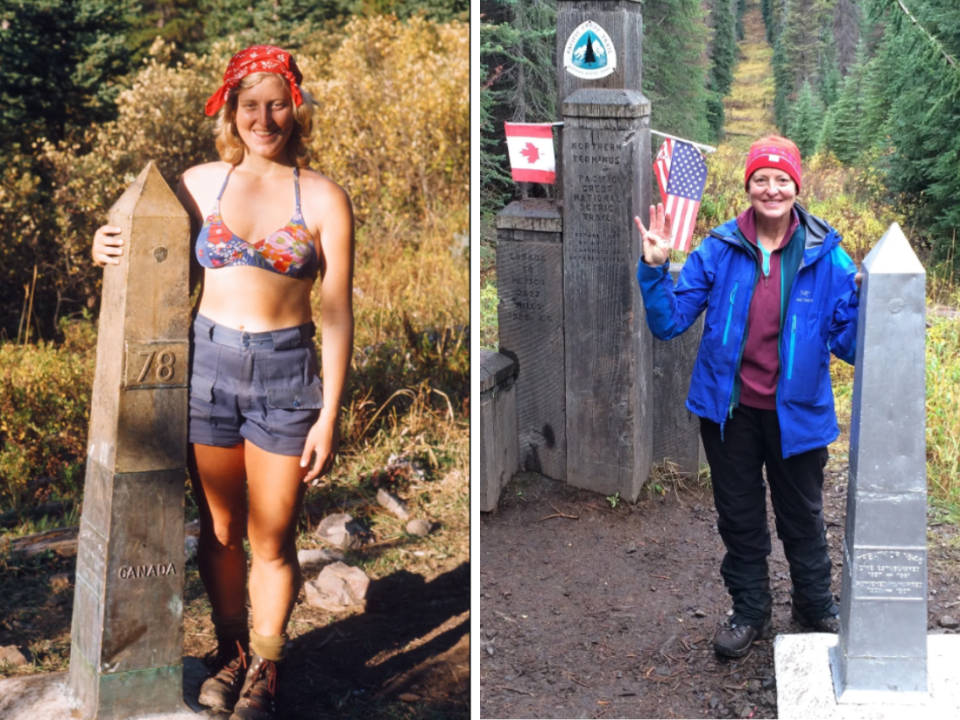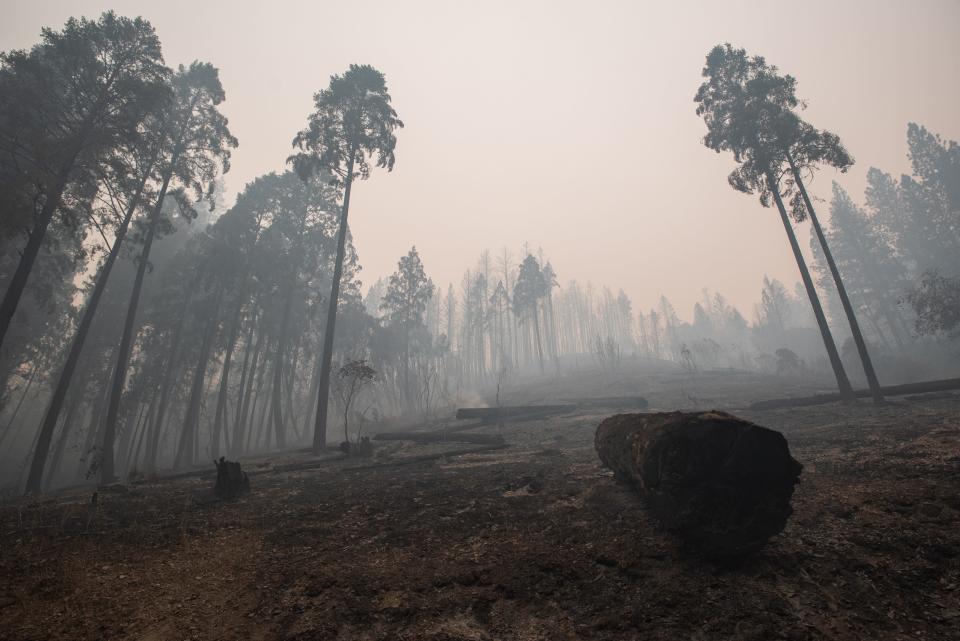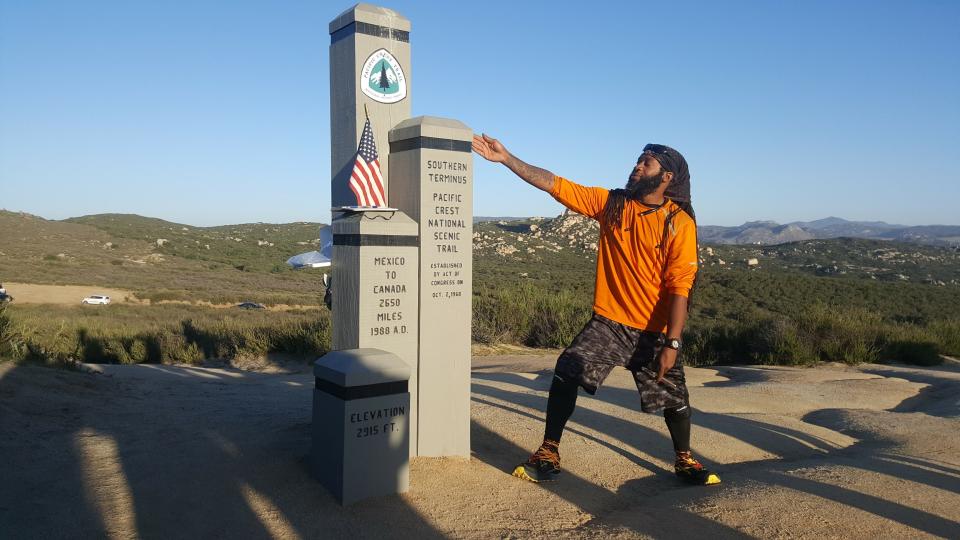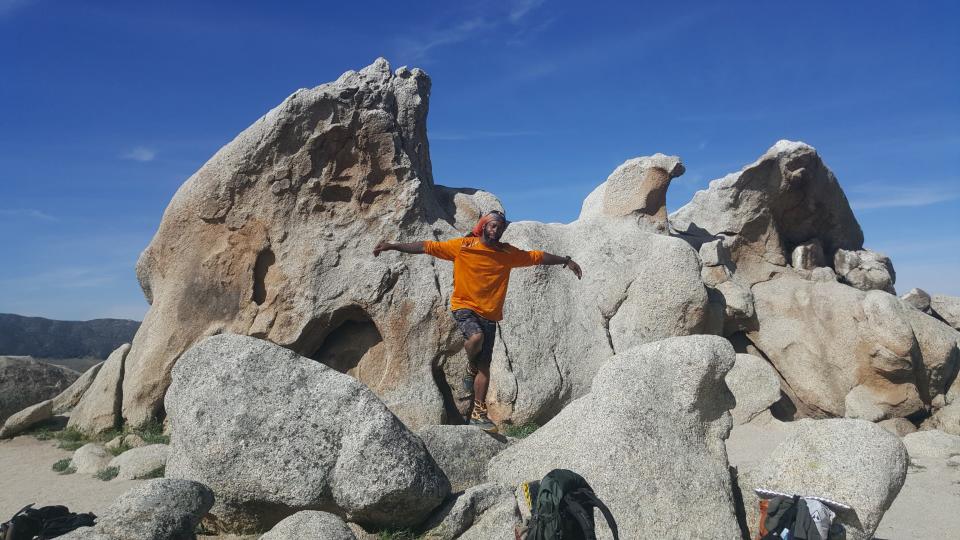How climate change is destroying the 'Wild' experience of hiking the Pacific Crest Trail
When Carolyn Burkhart walked from Mexico to Canada 46 years ago, she pieced together her route along remote trails and logging roads, navigating with torn paper maps and a 50-pound pack bouncing on her back.
Her hike along the vaguely defined Pacific Crest Trail took six months, as she trekked through forests and deserts, across snowy mountain passes, out of touch for weeks at a time. Occasionally crossing paths with hikers making the same epic journey, she'd compare notes about finding their way.
Just 11 people made the journey that year, making Burkhart and those 10 others literal trailblazers along a route designated by Congress in 1968 but not yet formally laid out on any maps. The forests were lush, the snows deep, the route vague.
"Back then, for maybe one-third of California, there was no trail," said Burkhart, who believes she was the first woman to hike the trail alone.

Today, modern PCT hikers known as thru-hikers make the grueling trek in about five months, aided by lighter camping gear but also a precisely defined 2,650-mile route they download to their phones and GPS trackers. In 2019, the last year before pandemic restrictions, nearly 1,000 people completed the hike, with 1,189 finishers in 2018.
But while the trail today is clearly defined, there's a growing challenge that Burkhart or her peers never envisioned in the 1970s: Increasingly devastating wildfires are forcing land managers each year to temporarily close large sections of the trail for safety.
And those closures are raising questions about whether future generations of hikers will ever be able to complete the epic journey in a single year.
After all, who wants to spend months hiking though forests devastated by catastrophic wildfires, complicating what is already a body-shredding journey?
"Hiking in smoke is terrible and is really bad for the lungs, obviously," said Emory Wanger, who hiked on the PCT in 2017. While he hasn't experienced major side effects, he said many people get headaches and sometimes nosebleeds from smoke.
"Some push through, but I’ve also seen smoke end a hike entirely. The thicker the smoke, the worse it is and it really sucks if you’re stuck on a section where bailing is not an option," he said.
He added: "As for reroutes, it’s a gut punch and often adds road walking, hitching or additional miles that were not accounted for just to reach a trailhead."
IN COLORADO: People die summitting 14,000-foot mountain peaks. These climbers do it anyway.

Almost no one finishes the PCT
Congress created the Pacific Crest National Scenic Trail to help Americans access and enjoy public lands. Although the general route was finalized in 1972, the trail wasn't finished until 1993, with rangers linking existing trails with new stretches, replacing the logging roads Burkhart used.
Although millions of people hike on portions of the PCT, only about 800 to 1,000 people annually complete what's considered a true thru-hike: walking the entire trail from start to finish in a single summer.
To date, 8,671 people have attested their completion, the vast majority of them since the 2012 publication of Cheryl Strayed's book "Wild: From Lost to Found on the Pacific Crest Trail," according to the Pacific Crest Trail Association. About 780 people completed the trail in 2021.
Hikers have traditionally walked from south to north, chasing the spring thaw up and over California's Sierras so they can finish up in at the Canadian border before the winter snows return.
Will "Akuna" Robinson, 41, first heard about the Pacific Crest Trail in when he saw the movie "Wild," which features actress Reese Witherspoon as author Strayed. Robinson had returned from war in Iraq and was depressed, disabled and battling PTSD.
"I’d never backpacked in my life, but I knew that was I needed to do," said Robinson, who is now a sponsored hiker based in Texas. "I got on Amazon right then and I was on the trail a couple of weeks later."

That first go, Robinson hiked about 1,500 miles but had to leave due to injuries. He re-started and finished the trail in 2017 on his way to becoming the first Black man to complete what's known as the Triple Crown of thru-hiking: the PCT, the 2,190-mile Appalachian Trail, and the 3,100-mile Continental Divide Trail.
Hiking the trail requires more than just walking. Because it's impossible to carry enough food for the entire journey, most hikers establish food drops, either by mailing packages to themselves to be held at local post offices, or by arranging drop-offs where trails cross roads. And because weather conditions vary, many thru-hikers swap out sleeping gear, shelters and clothes as needed.
On the trail, hikers leapfrog each other, sometimes for the entire season, sometimes walking with a group, sometimes alone. And they usually adopt a trail persona or nickname. Robinson's references the phrase "hakuna matata," popularized in the 1994 Disney animated movie "The Lion King."
When he started his hike, Robinson closely followed the exact PCT route. But after thousands of miles of hiking, he's come to understand the actual route doesn't matter that much.
"For me, it really just is about hiking the trail that's open to you," Robinson said. "You might think you're in control but you're not. Nature is. And you have to adjust and adapt."

How climate change is changing the journey for hikers
That attitude is increasingly what Mother Nature requires, said Scott Wilkinson, a spokesman for the Pacific Crest Trail Association. The nonprofit oversees thru-hiker permits, and Wilkinson said trail closures monitored by the PCTA have increased, particularly since 2020, when there was always at least some portion of the trail closed during the main hiking season of April to September.
"Particularly in the past two or three years, it's been difficult, if not impossible, to hike every mile of the trail in order from one end to the other," Wilkinson said. "It's absolutely a concern, and it's concern driven by climate change."
The amount of land burned by wildfires annually has quintupled from when Burkhart hiked the trail, according to researchers at UC San Diego Scripps’ Center for Western Weather and Water Extremes. They predict more large-scale wildfires will burn in months that were traditionally fire-free.
FIGHTING FIRE WITH FIRE: Controlled burns remain essential as wildfires intensify
TRAVEL: What national parks can do to make the outdoors more accessible
Meanwhile, hikers in California are already seeing the impact of climate change on the trail, from shorter, warmer winters to unusually heavy rainfall caused by atmospheric rivers, the researchers said.
"For the most part, dealing with the weather is fine: a storm moves in and you can hunker down, you can wait for it to pass," Wanger said, who hiked the PCT in 2017 after serving two tours as a Marine in Iraq. "But the thing that closes down a trail is fire. There are no ifs, ands, and buts about it."
Wanger said he's seen a growing trend of thru-hikers fixated on "redlining" the trail, where they feel compelled to follow the trail's exact mapped route via GPS. He doesn't consider himself a true thru-hiker because he missed hiking 100 miles of an unusually snowy portion during his hike.
"Every single year, the trail is different," said Wanger, 38. "Thru-hiking, I realized at the end of it, it's not so much a hike. It's more of a pilgrimage. What I regret missing most is the things I would have learned about myself on those sections, rather than the regret of the actual miles I missed."
Experts say the challenge of hiking the PCT will continue growing as long as climate change keeps exacerbating existing fire danger in forests that are already primed to burn due to drought.
In Northern California's Lassen Volcanic National Park, the Dixie Fire in 2021 prompted widespread trail closures, including a 20-mile section of the PCT. Park managers closed the trails before the fire even arrived, worried out-of-touch hikers might get trapped by the advancing flames, said Amanda Sweeney, one of the park's rangers. The closures blocked some hikers from finishing the trail.
Today, the Drakesbad Guest Ranch inside the park, along with a campground — both popular with PCT hikers looking for showers and toilets — remain closed, even though the trail is back open.
"That window for PCT hikers is small. Even a short closure can have a huge effect," Sweeney said. "And that Dixie Fire footprint is massive, so even with the trail being open, the experience is so awful that a lot of people were opting to skip that section."
DIXIE WILDFIRE'S AFTERMATH: Charred buildings, burned cars and an abandoned town
Wildfire smoke itself is unhealthy to breathe, even from hundreds of miles away, and burned areas are dangerous to hike through because embers can smolder for weeks, dead trees can topple, and mudslides can destroy the trail.
UCLA professor Glen MacDonald said the forests Burkhart hiked through in the 1970s saw fewer and smaller wildfires, in part because federal officials aggressively extinguished them. But that policy ultimately led to unhealthier forests primed to burn, he said, and now those ready-to-burn forests are even more dangerous due to ongoing drought and a longer wildfire season.
MacDonald, who is the John Muir Memorial Chair in Geography, said he recently had to end a forest research project because there was so much smoke in the air.
"Hiking through a burned landscape is not that pleasant. It's not pleasant visually but you also have all that ash and dust," he said, adding that the fires cause water quality issues.
'Every mile has meaning'
While it's easy to say hikers should simply alter their route, younger backpackers who grew up watching YouTube videos, reading Strayed's book or seeing the movie are heavily invested in seeing specific sights, said Chris "Rad" Carter, 26. Carter thru-hiked the PCT in 2018 and then did both the Appalachian and Continental Divide trails in 2021.
"We want to experience every mile because every mile now has meaning," he said. "It's a magical journey, and to be asked to skip 700 miles because of a fire, well, this isn't just a weekend adventure."
Craig "Oh That Craig" Giffen, 49, remembers seeing the same rock formations from different angles because the trail was re-routed in between his journeys when he hiked large portions of the trail in 1994, thru-hiked it in 1996, and then again in 2013. Giffen in 1997 created what has become a popular PCT planning website, using his expertise as a computer programmer to help hikers plot their route and resupply stops.
He got his nickname because so many of the hikers he encountered knew his name from the planning website.
"It's hard to hike it 'correctly,'" Giffen said of the PCT. "Jobs come and go. Relationships come and go. But the trail will always be there."

'Change your path'
For decades, Burkhart's name and identity have been closely tied to the PCT.
Burkhart, whose nickname is Ravensong because she can imitate ravens, operated a hikers lodge called Ravensong’s Roost in Mazama, Washington, about 30 miles from the trail's northern terminus at the Canadian border, often hiking portions of the trail with her kids.
But she recently sold the lodge. Speaking to USA TODAY from Norway, where she now lives, she recalled how the southern portions of California used to be greener, with more water available. The more frequent wildfires have become, the less she wanted to hike there anymore, she said.
Burkhart encouraged hikers to reconsider what it means to hike the PCT in a time of wildfires, not just from a simple logistics standpoint, but from a philosophical one.
"We're talking about a journey from Mexico to Canada or the reverse," she said. "It's not about just following a line on a map. This is journey. The destination is not necessarily the point."
This article originally appeared on USA TODAY: Hiking the PCT: How climate change is ruining the Pacific Crest Trail

